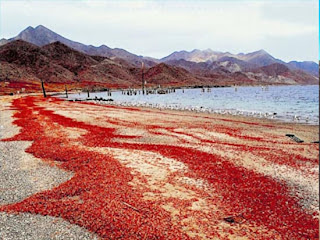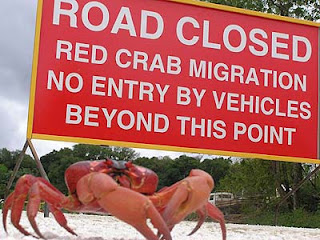
The Christmas Island red crab, Gecarcoidea natalis, is a species of land crab that is endemic to Christmas Island and the Cocos (Keeling) Islands in the Indian Ocean.
Although restricted to a relatively small area, it has been estimated that 43.7 million adult red crabs lived on Christmas Island alone, but the accidental introduction of the yellow crazy ant is believed to have killed about 10–15 million of these in recent years. Christmas Island red crabs eat mostly fallen leaves and flowers, but will occasionally eat other animals, including other red crabs (see cannibalism) if the opportunity arises.
Bright red is the common colour but there are the occasional orange specimens and more rarely some purple animals. They are a big crab. An adult body shell (or carapace) may measure up to 116mm across. The Christmas Island red crabs' carapace is round shouldered and encloses their lungs and gills. Their claws are usually of equal size unless one is a regrowing claw. Males grow larger overall than females, while females have a much broader abdomen and usually have smaller claws than males. However young Christmas Island red crabs all have the characteristic narrow abdomen of the male. The broader abdomen on the female Christmas Island red crab only becomes apparent in the third year of growth.
Christmas Island red crabs grow slowly, reaching about 40mm in carapace width after 4-5 years. They are sexually mature at this age and begin to participate in the breeding migrations.
The Christmas Island red crabs moult their shells regularly during their early growth phases to match their increasing body size. Moulting usually takes place in the protected moist environment of their burrows. Mature Christmas Island red crabs probably moult only once a year, as their growth rate slows.
Red Crabs diet consists mainly of fallen leaves, fruits, flowers and seedlings. They prefer fresh green leaves but will eat any fallen leaves. They are not solely vegetarian however. They will eat other dead crabs and birds, the introduced Giant African snail and palatable human rubbish if the opportunity presents itself.
They have virtually no competition for their food resource due to their high numbers and dominance of the forest floor.
Christmas red crabs live in burrows for shelter from the sun. Since they breathe through gills, the possibility of drying out is dangerous. They are famous for their annual migration to the sea to lay their eggs in the ocean.
Early inhabitants of Christmas Island rarely mentioned these crabs. It is possible that their large population size was caused by the extinction of the endemic Maclear's Rat, Rattus macleari in 1903, which may have controlled the crab's population. Surveys have found a density 0.09–0.57 adult red crabs per square metre, equalling an estimated total population of 43.7 million on Christmas Island. Others have estimated that about 120 million are found on this island, but the basis for that claim is unclear.
An exploding population of the yellow crazy ant, an invasive species accidentally introduced to Christmas Island and Australia from Africa, is believed to have killed 10–15 million red crabs (one-quarter to one-third of the total population) in recent years. In total (including killed), the ants are believed to have displaced 15–20 million red crabs on Christmas Island.
The Breeding Calendar
Males lead the first wave of the downward migration and are joined by females as they progress. Larger males arrive at the sea first (after about 5-7 days) but are soon outnumbered by females. The crabs replenish moisture by dipping in the sea, then the males retreat to the lower terraces to dig burrows. The density of burrows is high (1-2 per square metre and fighting occurs between males for burrow possession. The females move to the terraces and mating occurs, usually in the privacy of the burrows that males have dug and fought for. As mating, and fighting, abates, males dip again and begin returning inland. They move quickly, reaching the plateau in only 1-2 days.
The females produce eggs within 3 days of mating and remain in the moist burrows on the terraces for 12-13 days while they develop. The eggs are held in a brood pouch between their extended abdomen and thorax. A single female can brood up to 100,000 eggs.
In the morning and late afternoon around the last quarter of the moon, the egg-laden females descend from the terraces to the shoreline. They pack into shaded areas above the waterline at densities of up to 100 per square metre in places. The females usually release their eggs into the sea toward dawn, around the turn of the high tide. Release of eggs may occur on 5-6 consecutive nights during the main breeding migration. After the first two days, eggless females may be seen crossing plateau roads, kilometres from the shore.
If the spawning migration is delayed or disrupted, usually because of unfavorable weather conditions, both male and female crabs will remain on the terraces for the next month and complete the spawning one lunar month later.
Larvae Grow To Baby Crabs In The Sea
The eggs released by the females hatch immediately on contact with the sea water and clouds of young larvae swirl near the shore before being washed out to sea by waves and tides. Millions of the larvae are eaten by fish and plankton feeders such as Manta Rays and the enormous Whale Sharks which visit Christmas Island waters during the crab spawning season.
After about a month in the ocean, and after growing through several larval stages, the surviving larvae have developed into prawn-like animals called megalopae. The megalopae gather in pools close to the shore for 1-2 days before changing into young crabs and leaving the water.
Although only 5mm across, the baby crabs begin their march inland, taking about 9 days to reach the plateau. Here they seem to disappear and are rarely seen, living in rocky outcrops and under fallen tree branches and debris on the forest floor for the first three years of their life.
In many years, very few or no baby crabs emerge from the sea, but the occasional very successful year (perhaps only one or two every ten years) is enough to maintain the Red Crab population to a high level.
Impact Of Humans
Certain human activities have led to increased numbers of Red Crabs dying during their annual migration to the sea. As well as there being a greater risk of crabs dehydrating when forced to cross areas cleared of forest cover, thousands of adults and young are crushed by vehicles while crossing roads. Some have to negotiate up to three or four such hazards on their descent and ascent each year. Conservation measures have been implemented to help reduce this high death toll.
To reduce the number of crabs killed by vehicles during the migration, 'crab crossings' are being constructed in roads which cross main crab migration paths. Points where high numbers of Red Crabs cross roads have been identified, and tunnels are built under the road for crabs to pass through. Walls that the crabs can not climb over are built alongside the road to 'funnel' the migrating crabs through the tunnels. These crab crossings may be seen on the Lily Beach road. Other conservation measures used by the community are road closures and traffic detours around the major migration paths during peak periods of the migration.
Source :
wikipedia.org
australiangeographic.com.au
**************************************
Melaka Planetarium Adventure Science Centre






0 comments:
Post a Comment